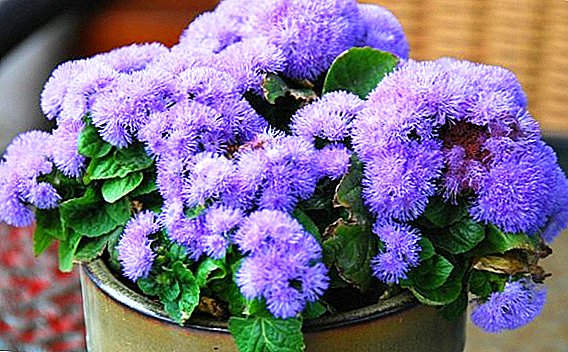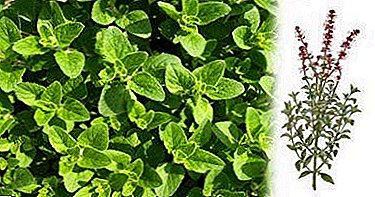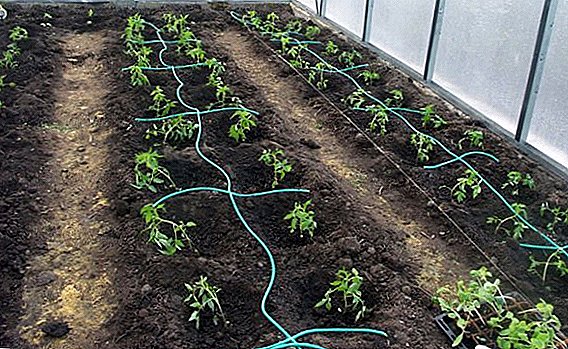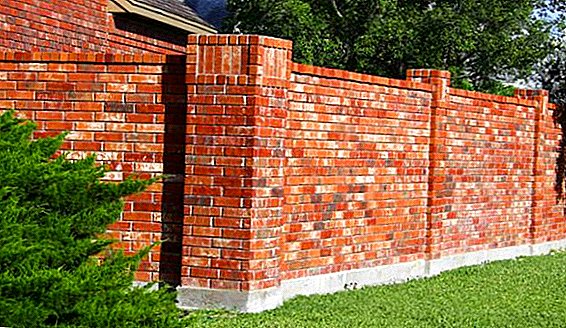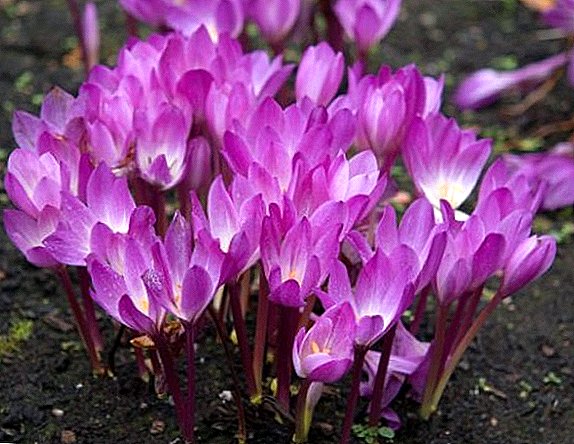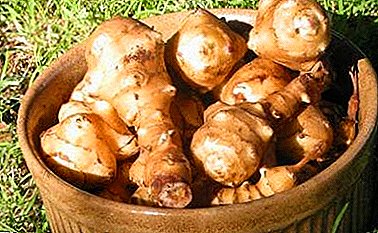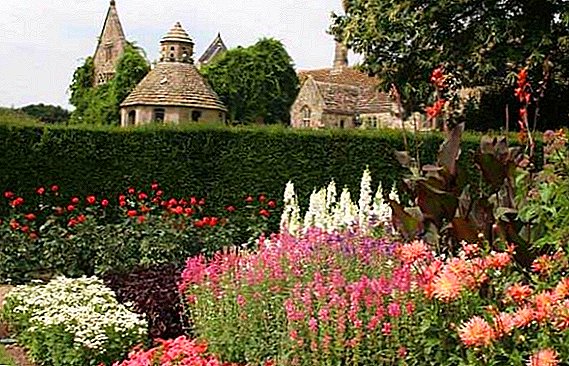 Mixborder - it is quite practical and very beautiful element of landscape design, which is a combined flower bed of long continuous flowering.
Mixborder - it is quite practical and very beautiful element of landscape design, which is a combined flower bed of long continuous flowering.
Such well-chosen and well-groomed flowerbeds are becoming more popular and able to give beauty all year round.
They begin to understand their special value at the time of late autumn, when everything around is gray and dull, and only a colorful island with evergreens can bring joy. To comprehend the science of creating mixborders, everyone can, and this will help ready-made schemes of flower beds.
Where to start?
Indeed, the art of creating combined flower gardens is not difficult for the development and practical application, but the main thing is to know how to approach this issue in the initial stages.
Before you decide to acquire such a grand flowerbed, you must clearly understand that planting everything beautifully, harmoniously and successfully is one side of the issue, but then taking care of such beauty is the other side, and, as experience shows, it is much more difficult than the first.
If you understand what you can do, then you can proceed. First, you need to create schemes for planting mixborders from conifers and shrubs, perennial and annual crops, taking into account all the nuances of their successful placement.  With such planning, it is necessary to take into account the composition of the soil, its appearance, the humidity of the earth and air, a sunny or shady place, and accessibility for wind and drafts.
With such planning, it is necessary to take into account the composition of the soil, its appearance, the humidity of the earth and air, a sunny or shady place, and accessibility for wind and drafts.
Only after taking into account all factors and drawing up a project for placing crops, can you buy seeds, seedlings and seedlings.
Important! It is not recommended to use a lot of cultures in contrast to the color gamut - the flower garden merges into a continuous spot, and in the eyes there appears discomfort, a feeling of ripples.
Location selection
Mixborders are best placed in open areas with unobstructed access to sunlight. Some mixborders feel good on slightly shaded places.
In order for the cultures to develop and grow well, look beautiful and fresh, they must be planted in fertilized, not depleted soil.
Before planting it is necessary to dig the site, loosen and fluff the soil, fertilize, do away with all weeds. 
Selection of plants
Ready colorful, rich and harmonious mixborders are the result of an exciting, but very time consuming process, the result of such efforts directly depends on the correct selection of cultures for compositions.
It is only out of ignorance, it seems that all the plants on the mixborder are planted haphazardly, randomly. It is not, everything is thought out to the smallest detail.
Important! The basic principle of mixborder: the height of plants gradually decreases. It is not recommended to plant next to strongly differing height of culture, and near the flower bed - tall plants covering his view. Among conifers for creating landscape design it is better to use dwarf species, deciduous should not be aggressive.
After the soil has been prepared for planting, and the site is conventionally divided into three parts of different sizes, crops with volumetric forms and interesting leaves are planted in the very back of the flower garden; rather tall flowering plants with upright stems are planted in front of them; sredneroslyh cultures without leaf splendor, in front of them - low plants with ground cover effect, and annual crops are closest to the front of the composition.  The front low rows camouflage long stems of plants located on the penultimate plane. If the mixborder has a rounded shape, then everything needs to be seated in the same way, with the only difference being that high cultures are placed in the center, and then downward.
The front low rows camouflage long stems of plants located on the penultimate plane. If the mixborder has a rounded shape, then everything needs to be seated in the same way, with the only difference being that high cultures are placed in the center, and then downward.
Cultures in the mixborder are placed smoothly flowing into each other in groups with a sufficient level of density.
All separate groups should have free spaces between them for further effective care and some sprawl.
Such a flowerbed will delight everyone from spring to late autumn, if the plants for her are picked up so that after the flowering of one, it will immediately begin to bloom another.
Did you know? The most ancient landscape design - Chinese, taking sources about a thousand years before our era. But the concept itself "landscape architecture" there was only some two hundred years ago.
 An important role in creating a decorative mixborder effect is played by cultures with beautiful rich green foliage, which does not allow the composition to lose its pomp and attractive appearance.
An important role in creating a decorative mixborder effect is played by cultures with beautiful rich green foliage, which does not allow the composition to lose its pomp and attractive appearance.Shrub mixborders are placed along the fences, buildings. They most often are perennial compositions in which all the bushes undergo a “stylish” haircut, the same ones that bloom should have a rather neat crown.
The cultures growing in the form of a bush and blooming at the same time include rhododendron, barberry, forsythia, hydrangea, spirea.
Perfectly in composition with them are perceived evergreen iberis, mahonia, boxwood. Cultures with ground cover effect: stonecrop, carpet phlox, periwinkle, yaskolka - also look good in mixborder.
To fill the voids formed, you can use perennial hosts, viols, daisies, primroses.
After creating a plan for placing the plants on the site and preparing the soil, you can place the crops according to the scheme on the flowerbed itself, this will help to visualize the entire future mixborder and understand some mistakes in order to eliminate them even before planting the plants in a permanent place.  When planting plants, it is imperative to think about how much space each of them will take after it fully grows, and take this important moment into account.
When planting plants, it is imperative to think about how much space each of them will take after it fully grows, and take this important moment into account.
If cultures are placed at a great distance from each other, then the mixborder will look empty, and free areas will quickly “occupy” weeds, but if they are planted very close, ornamental plants will not be able to grow at full power, and those that grow faster , drowned out more "slow" cultures.
Planting cultures is best to start from the center or from the highest plant.
Important! Continuity flowering mixborder can be achieved with the help of annuals that can bloom for a long time. If for some time he was not very attractive, then you can get out of the situation with the help of flowers in pots, arranging them for some period on a flower bed.

Benefits of using conifers
In each mixborder, so-called “skeletal” plants should be involved, which in composition are the main elements that create the evergreen presence of winter and give the fragrant and variegated flower garden a little “elevated” form.
It is perennial conifers with their tendency to high growth that look great in the role of "first violins" in such a fragrant orchestra.
The ephedra look elegant, elegant and elegant at any time. This is the most unassuming plants that do not require careful maintenance.
Even more attractive to conifers give them various forms of shrub, tree, spruce.
They look beautiful all year round, while other cultures show off their beauty only for a certain limited and not very long time. Compositions from coniferous and ornamental shrubs look especially attractive.  In the warm period, the hvoyniki, becoming a decorating background for summer plants that have lost their short charm, draw attention to themselves, and in the cold winter period, they, being a soloist, can themselves be perceived as a complete design decision.
In the warm period, the hvoyniki, becoming a decorating background for summer plants that have lost their short charm, draw attention to themselves, and in the cold winter period, they, being a soloist, can themselves be perceived as a complete design decision.
Important! It is necessary to use various decorative elements in the mixborder carefully enough not to overdo it and make it look ridiculous. To prevent this from happening, it is recommended to add large stones to the mixborder with conifers and shrubs so that they are randomly viewed between plantations.
Conifer for Mixborder
With coniferous plants, you can organize many options for decorative compositions, beds of conifers and shrubs using perennial and annual crops are very diverse. For this purpose, use different conifers.
- Ate have different shades of color, so they are of particular decorative value.
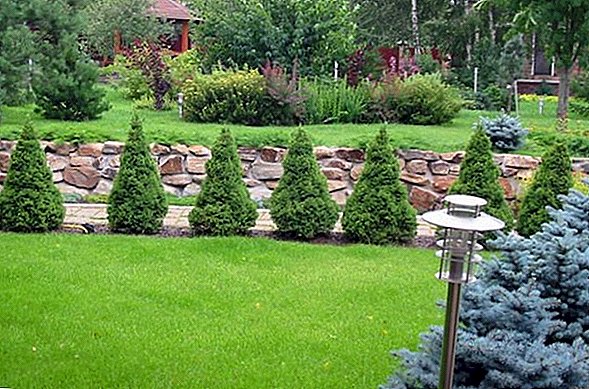
Did you know? French decorator Jacques Garcia, after restoring, renovating and refining the park at his estate Champ de Bataille, was awarded the Order of Merit for agriculture.
- Korean fir silver tide is peculiar, also amazing lilac cones grow on them.

- Pine Bergman has a curly appearance, and mountain pine - the shape of a pyramid.
id: 52002
- Thuja folded has a large crown going down to the ground. Yellow-crown thuis show themselves to be a little more capricious than other conifers, but over time this becomes almost imperceptible.

- Have low juniper branches creep along the ground, he himself feels good in the constant sun, does not fade and does not require special care.

- Have yew tree Branches with original red berries take the form of a fan and look amazing.

Did you know? Alkaloid paclitaxel, contained in the yew tree, is an effective remedy to combat certain types of cancer.
- Weeping larch, Japanese thistle, elfin cedar in their own way attractive.
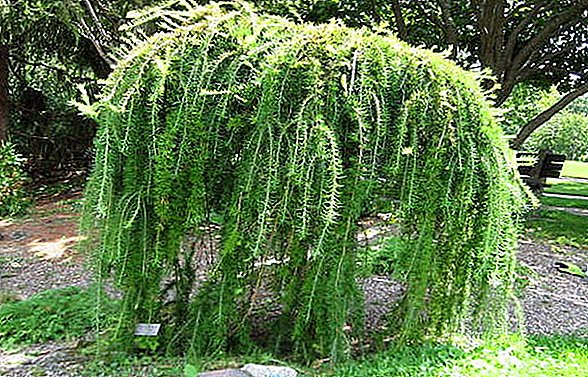
In mixborders, conifers are best combined with deciduous trees and shrubs, and supplemented with perennial and annual flowering crops.
The success of this combination, in the first place, will depend on the reasonableness of such a composition: even inconspicuous plantings will not be possible to admire, if they are seated correctly in color, shape and height.
For example, against the background of beautiful needles, irises, geyher, daylily, daffodils look great. Compositions of dwarf conifer varieties, heather, rhododendrons look spectacular.
Spiral high thuis surrounded by smaller columnar thujas and shrubs in spherical shapes look attractive if there is still free space covered by creeping juniper and stones, other than decorative purpose, serving as an original path along which you can approach any planting.
The conifers have many forms that can be the highlight of any composition. 
Important! Conifers, like many other expensive plants, are sold with an earthy clod, in which the root system is hidden. Before planting the container must be lowered into the water so that the soil will be soaked with it. The main thing: a lump with roots when planting should be at the same level relative to the surface of the earth as in the pot. If a coniferous plant is planted higher, it will wither, bury it in the ground - it can rot. Planted conifers need sufficient air humidity, so in the evening they must not only be watered, but also sprayed. The landing site is recommended at first to be slightly pritenyat.
Rules of combining plants
Experienced flower growers think through everything during the mixborder design and know that it is impossible to plant the plants "at random, if only it was beautiful."
For example, there is no need to plant perennials with creeping rhizomes that can suppress the growth of weeds, because they also have a negative effect on some ornamental plants. For example, wormwood suppresses such bulbous cultures as lily of the valley and others.  Beginners lovers of design of flower beds are planted next to each other, not knowing all the requirements and nuances of growing certain types of crops, many incompatible types of them, turning the mixborder into something vague, unaesthetic and neglected.
Beginners lovers of design of flower beds are planted next to each other, not knowing all the requirements and nuances of growing certain types of crops, many incompatible types of them, turning the mixborder into something vague, unaesthetic and neglected.
After all, some types of cultures feel great next to each other, and there are those that do not tolerate one another’s neighborhood or simply cannot develop fully.
It turns out that lilies are not very comfortable near roses, and roses are good near cereals and lavender. Marigold, chamomile, yarrow feel great next to any cultures.
Wormwood suited the neighborhood of trees and shrubs, but not flowers. Before you draw a scheme of flower beds from perennials and annuals and plant cultures, you need to familiarize yourself with how they transfer each other.
After all, it is important not only how cultures fit each other externally, but whether they also harm each other.  Coniferous crops harmoniously look next to the yellow flowers of cinquefoil, the red-leaved barberry of Thunberg, with shiny green leaves and red fruit of the cotoneaster horizontal.
Coniferous crops harmoniously look next to the yellow flowers of cinquefoil, the red-leaved barberry of Thunberg, with shiny green leaves and red fruit of the cotoneaster horizontal.
Well combined with coniferous perennials such as geykhera, Carpathian bell, stonegrass [/ url shade], all kinds of carnations, periwinkle.
Blue creeping and columnar junipers look stylish next to dull perennial plants. The blue ball-shaped spruce in a composition with cultures of red flowers looks very beautiful.
The bluish, blue, gray tones of conifers contribute to the elegance and smoothing of contrasts in the mixborder, and during the winter period decorate the landscape.
Colorful conifers look best in solitude, but you can pick up one-color ground cover plants, shrubs with a small crown or other hvoyniki.
Ready schemes
If you decide to design a miksborder, the schemes of flower beds of perennials and annuals, allowing you to create a composition with your own hands, will definitely come in handy. Here is one of them: 
Peculiarities of care
Care for mixborders, consisting of different plant species, is quite difficult. They need timely transplantation, reclamation, watering, pruning, fertilizer, disease prevention.
The advantage of a mixborder based on coniferous plants is that it does not require special care, because such perennial plants do not need to be replanted or sown like summer ones.
Important! Crumbled needles significantly oxidize the soil, where it becomes impossible to grow other crops, so you need to clean it more often. So she fights for her place in the sun. Large adult plants take a lot of moisture from the ground, so small plants need additional watering.
Mixborder is a great design solution that can bring joy for almost the whole year. Coniferous plants in such a composition occupy the main place, they have different semantic load in the summer and winter period. 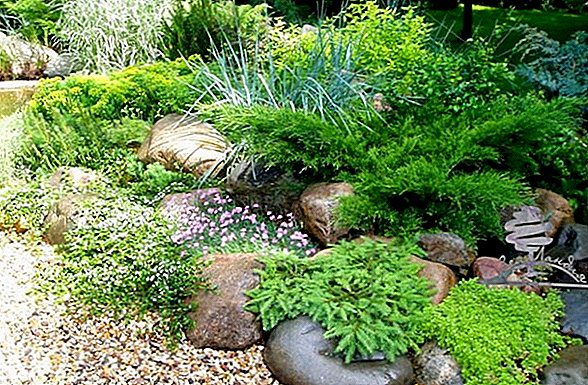 But the main thing is that they look great both separately and in combination with various decorative cultures, without requiring much effort from gardeners in terms of caring for them. For those who conceived the mixborder, the ephedra is the universal solution for the basic composition.
But the main thing is that they look great both separately and in combination with various decorative cultures, without requiring much effort from gardeners in terms of caring for them. For those who conceived the mixborder, the ephedra is the universal solution for the basic composition.









